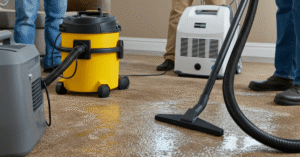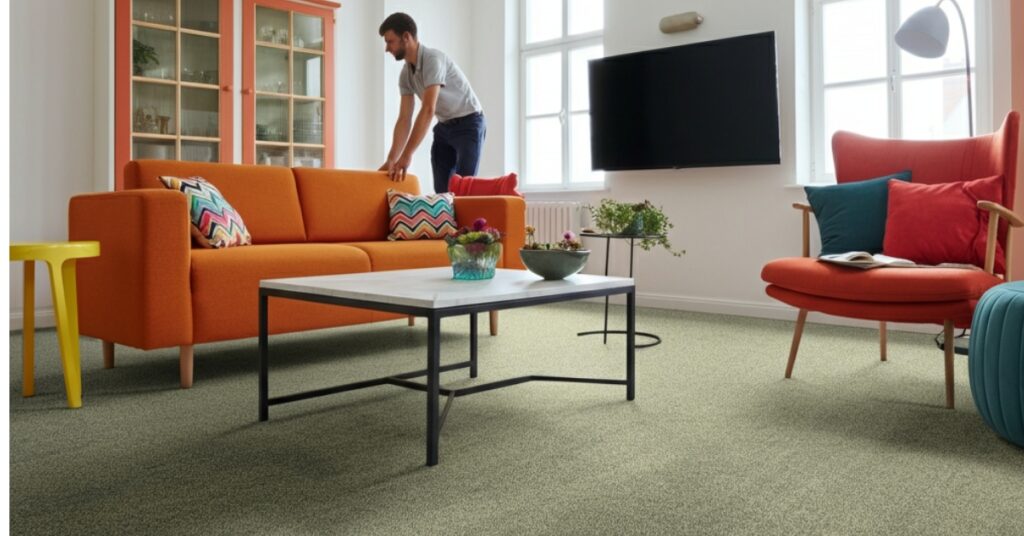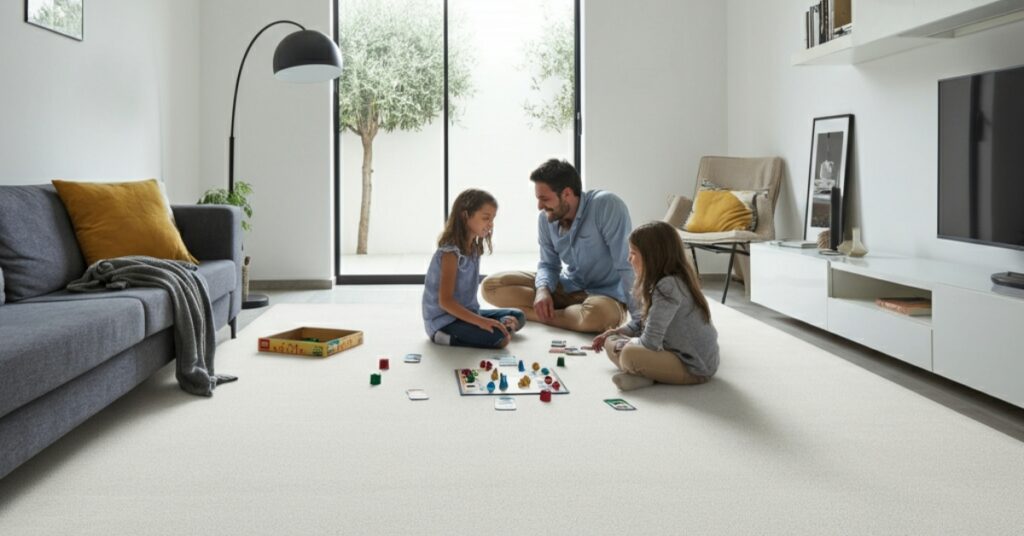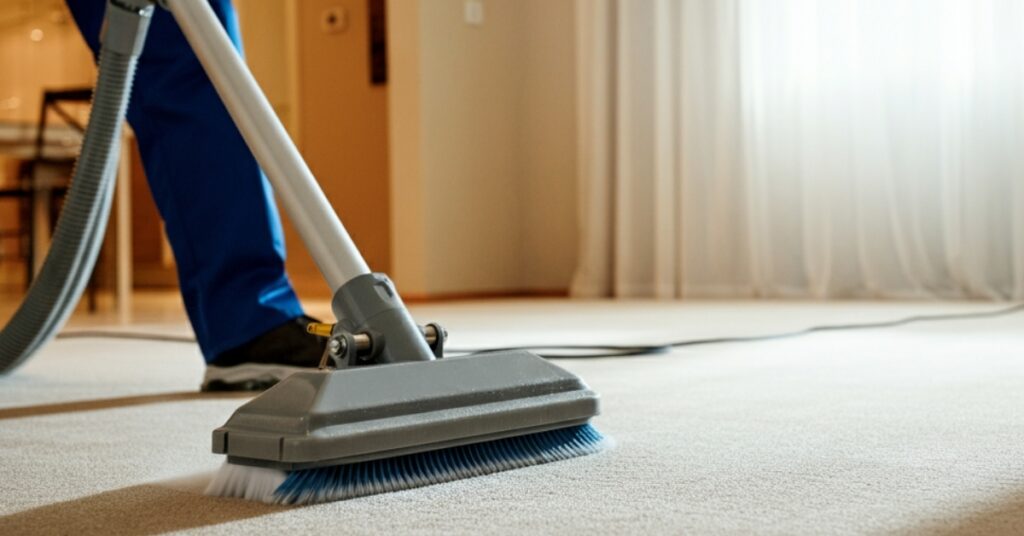As an Amazon Associate, I earn from qualifying purchases.
Cleaning carpets is essential for maintaining a dirt-free and healthy home. However, the drying process plays a critical role as well. Knowing how to dry carpet after cleaning is vital, because allowing carpets to remain damp for extended periods can lead to mold, mildew, unpleasant odors, and even structural damage to the carpet.
Taking the right measures during the drying process ensures that the carpet is not only well taken care of but also contributes to a clean, mold-free, and healthy home. In this article, we will explain why it is essential to dry carpets properly, offer tips on how to dry carpets effectively after cleaning, and provide tools that can help accelerate the drying process.
Why Proper Carpet Drying Matters

You might think drying a carpet is an easy job, but there are real risks to not paying enough attention. Here’s why ensuring your carpet is completely dry is essential.
Prevent Mold and Mildew Growth
Wet carpets are the perfect host for mold and mildew. These not only damage the carpets but can also cause health problems. For sensitive people, mold can trigger allergic reactions, breathing difficulties, and various other health issues. Properly drying prevents mold and mildew from forming.
Effective carpet drying starts with having the right tools to remove heat, scrub air, and ensure proper circulation to reduce moisture. Homes with high humidity require stronger air conditioning. Drying carpets that have thick padding or dense fibers need the most attention because these retain moisture longer than low-pile carpets.
Preserve Carpet Texture and Lifespan
Excess moisture can weaken the fibers of a carpet, creating a loss in both texture and durability. For example, damp spots can result in the fibers bunching up and losing their softness or developing a rough texture. Preserving thorough drying helps maintain integrity in your carpet, allowing it to last longer and feel like new.
Air-dry natural fiber carpets like wool or cotton can risk stretching or shrinking. Synthetic carpets are not immune either; trapped water can degrade the latex backing and the bond with fibers, resulting in delamination or rippling. Proper drying is more critical than just ensuring the carpet is clean – it’s preserving the investment made to avoid early replacement.
Prevent Unpleasant Smells and Allergens
Even if a carpet appears clean, moisture can still help build bacteria that cause musty odors. This issue is more prevalent in high-temperature and humidity areas, where drying takes longer, making odor removal more challenging. A carpet deprived of moisture will eliminate these odors, ensuring the home stays fresh as well as free from allergens.
Bad smells coming from carpets are more than just annoying. They can indicate bacteria, mildew, or even chemical residues left behind from improper rinsing, and these issues can pose more serious problems. Additionally, moisture creates an environment that fosters the growth of dust mites, which can exacerbate asthma and allergies.
Pet owners have it worse because the combination of leftover moisture and pet hair increases allergens and odors. Therefore, swift drying is crucial for maintaining health and comfort. Now that we understand the importance of drying carpets, let us take a look at the most effective ways for drying them step by step.
How to Dry Carpet After Cleaning (Step-by-Step)
Failing to dry your carpet correctly can result in significant damage, so ensure you do it right the first time. If you follow the steps outlined in this guide, not only will you dry your carpet quickly, but you will also maintain your investment.
Step 1: Remove Excess Moisture
Before drying your carpet, it is important to remove as much excess water from it as possible so that the carpet is easier to dry:
- Extracting Excess Water with a Wet Vacuum: Moisture extraction is most effectively done with wet vacuums. Some machines can quickly and efficiently extract water from carpets, featuring strong suction power paired with a large capacity for handling larger areas.
- Blot with Towels: For small to medium-sized areas, use clean absorbent towels to soak up water. For best results, apply pressure and lift off the towels slowly to let the layers soaked in moisture dry out.
Tip: Do not rub the carpet with towels as this can damage the carpet fibers by breaking them or pushing water deeper into the fabric.
The best way to deal with towels is to combine them with a wet vacuum. It is best to start with the most damp area, before moving outward to less wet zones. To make soaking easier, rotate towels often. For patches that seem stubborn, putting clean socks or shoes on and standing on the towels increases pressure ,which helps remove water.
If you live in a multi-story house, you should pay extra attention to residues on the carpets. Wet carpets can leave damp spots beneath and in adjacent areas, due to the force of gravity.
Step 2: Increase Air Circulation
Drying carpets further requires improvements with respect to airflow, so let’s change that by:
- Positioning Fans Strategically: Ensure the fans are directed towards the surface of the carpets. With the use of influential air movers like the Soleaire Max Storm Air Mover, you will be able to dry large carpeted areas efficiently.
- Open Windows and Doors: When the day is nice, dry, and breezy, take advantage by keeping windows and doors open to encourage cross-ventilation. Fresh air can speed things up.
Pro Tip: In humid weather, it is best to keep windows closed, as it slows down the drying process and also encourages mold growth.
Simply turning on fans is less effective than strategically placing them. For maximum effect, place one fan to blow fresh air in and another to expel moist air out, creating a mini wind tunnel in the room. To best remove moisture, point fans to damp areas from every angle.
While oscillating fans are good for overall airflow, near walls and corners, small high-velocity fans improve targeting towards the moisture. Ceiling fans, if available, should be set counter-clockwise so air is pushed towards the carpet.
Step 3: Use Dehumidifiers
Dehumidifiers are perfect for areas with high humidity. Keep the dehumidifier in the same room as the soaked carpet and shut the doors to improve efficiency. How They Help: By extracting moisture from the air, dehumidifiers speed the evaporation of water from the carpet. Most modern dehumidifiers feature a digital humidity sensor, making it easier to maintain indoor humidity levels (ideally below 50%) within a comfortable range for quick drying.
You may need two dehumidifiers if the rooms are huge or have multiple areas with moisture. This device is a must if you are drying carpets in a basement. It helps reduce the moisture that naturally exists in basement spaces, preventing long-term issues with dampness and mold in the future.
Tip: Make sure to always remove the water container, clean the air intake filter, and the rest of the unit regularly to improve efficiency during carpet drying.
Step 4: Adjust HVAC Settings or Use Heaters
If you feel that the airflow is insufficient, use controlled heat sources to quicken the process:
- HVAC Options: Set your heating system to a lower, moderately warm temperature. Your HVAC system might provide steady airflow, which helps dry carpets evenly.
- Portable Heaters: These are also effective, but should be kept at a distance to avoid damaging the carpet.
Supplement heating by ramping up the furnace or using a space heater in the area. To ensure safety, do not direct space heaters at carpeted areas or leave the room unattended. For this purpose, infrared heaters are most effective as they radiate heat directly to carpets, aiding in the evaporation of any moisture.
In dry and cool areas, having air circulate with central heating is effective. Ensure that if radiators or baseboard heaters are used, the carpet has enough room to allow unrestricted airflow.
Step 5: Keep an Eye on Wet Spots and Give Time
Your carpet’s drying process includes the steps above. Once they are done, the next step would be to air dry your carpet naturally:
- Check Regularly: Over time, the corners and edges of the carpet dry out. To accelerate the process, gently feel for damp areas with your hands.
- Repeat as Needed: Adjust the position of your fans and resume the blotting process using towels to maintain pace in stubborn areas.
During the waiting period, remain patient. Rushing dry efforts pose risks of leaving behind moisture, which can lead to unpleasant smells and the spread of germs. If you think there’s too much moisture in the subfloor (common after floods or heavy soiling), lift the corner of the carpet (with gloves on!) to inspect both sides. Until both the surface and backing are dry, continue the drying efforts.
Best Tools to Speed Up Carpet Drying
Using the right tools can make carpet drying faster, easier, and more effective. Here’s a breakdown of the most efficient products:
1. Air Movers & Carpet Dryers
Air movers are designed to provide concentrated airflow:
Why They Work: These devices blow powerful air over carpets, helping evaporate moisture quickly.
Top Pick: The B-Air Grizzly GP-1 Air Mover is a high-powered machine ideal for large or heavily damp carpet areas.
Air movers can dry a freshly cleaned carpet in under half the time of traditional fans. Professional cleaners rely on them for a reason—they deliver focused air at low levels, ideal for sheet carpets and thick padding. For homeowners looking to invest in long-lasting, repeated results, these make a wise buy.
2. Box or Oscillating Fans
While not as powerful as air movers, standard fans are affordable and effective for smaller jobs:
- Place multiple fans in the room to ensure consistent airflow.
- Aim larger fans toward concentrated damp spots for faster results.
You can often combine box or oscillating fans with air movers for maximum efficiency. Place box fans along the perimeter of a room and oscillating fans over stubborn wet areas. Remember to move them a few times through the drying process to avoid dead zones with lingering moisture.
3. Dehumidifiers
When dry air is hard to come by, dehumidifiers are the best backup tool:
Example: The Vremi 50 Pint Dehumidifier is a premium choice for drying spaces with dense carpets or high humidity.
Consider choosing one with continuous drainage features for unattended long-term use, especially when dealing with large or commercial carpets. Dehumidifiers also double as excellent preventive maintenance tools for bathrooms, basements, or laundry rooms prone to water spills.
4. Wet Vacuums
A good wet vacuum is invaluable for waterlogged carpets:
Purpose: Extract pooled water quickly before it can seep further into the carpet.
Budget-Friendly Option: The Shop-Vac 12-Gallon Wet/Dry Vacuum offers durability and excellent performance.
For homes with pets or children, a wet/dry vacuum pays for itself many times over. Wet vacuums also excel at cleaning up after accidental spills or leaks, and their attachments let you reach corners and baseboards more effectively than most standard household vacuums.
5. Towels
For smaller stains or slightly damp areas, absorbent towels can save you time. They’re cost-effective and easy to use for spot drying.
Microfiber towels are especially efficient – they trap moisture and debris, leaving carpets cleaner and drier than those made from cotton alternatives. For thoroughness, layer several towels on wet spots, then place a heavy object (like a stack of books in a plastic bag) on top to draw out as much water as possible.
DIY vs. Professional-Grade Tools
For small jobs like simple spills, using a domestic fan or a rental wet vacuum is affordable and effective. On the contrary, if you deal with heavily soiled carpets and high foot traffic areas, or suffer from constant leaks, investing in professional-grade tools makes sense.
These types of tools not only save you time, but they also make sure no moisture is left in the carpets. For your home’s indoor air quality and your carpet’s warranty, this is vital. Factors such as the carpet’s maintenance method, the current environment, and available tools dictate how long it will take to dry a carpet. Here’s a breakdown of two carpet cleaning methods, along with additional factors that can assist with the drying time:
Steam VS Dry Cleaning
Steam Cleaning: This method is highly effective for deep cleaning carpets. Although steam cleaning leaves carpets partially damp, with an optimal environment of low humidity paired with good airflow and dehumidifiers/fans, carpets will typically dry in 6 to 12 hours. If the environment is humid, carpets may take 24 hours or more to dry.
Dry cleaning: With this method, most carpets are cleaned in 1 to 3 hours. For those who live in moist climates, this is the quickest method. Do not forget to follow the proper manufacturer’s step-by-step instructions. Always take caution with carpets that have thick padding and are heavily soiled.
To check if the carpets are dry, walk in socks or barefoot and verify if moisture is still present. If using socks, it’s a good idea to increase furniture readjustment for pets and children to visit the carpets by an additional hour.
Factors That Affect Drying
There are a few things that affect how long it takes your carpet to dry:
- Humidity: The level of water vapor in the air can significantly slow down how quickly the carpet dries. The use of a dehumidifier counteracts this challenge throughout the rainy and humid months.
- Carpet Material: Natural fibers like wool, cotton, and jute tend to take longer to dry when compared to synthetic fibers such as nylon and polyester, as they are more porous.
- Pile Height: Low-pile carpets dry faster as compared to high-pile and shag carpets which need more time due to the density and thickness.
- Room Size and Ventilation: Better airflow leads to faster drying; large rooms with less airflow will take longer to dry. Basements tend to need more attention due to their cool and damp nature.
- Season and Weather: The best time to dry carpets is during dry and warm seasons. Contrarily, rain or snow means longer drying time, supplemented by fans and dehumidifiers.
When to Walk on Carpet Again
Wait for the carpet to dry fully before walking on it again. This prevents damage to the carpet and stops oils from being transferred. It is best to wait 6–8 hours after dry cleaning and 12–24 hours after steam cleaning, depending on moisture levels and drying aids used.
To check, press a tissue or white paper towel on the carpet. If it comes away dry, your carpet is safe to use. If you must cross the room, use towels or plastic sheeting to keep the area clean.
Mistakes to Avoid When Drying Carpet

Drying carpets may seem straightforward, but even the most diligent homeowners can make common mistakes that lengthen drying times or lead to damp-related issues. The following errors are the most common:
- Ignoring Wet Spots: Moisture can be masked in corners, under furniture, or within thick carpet pads. Always check every section of an area by touch, and if possible, use a moisture meter.
- Leaving Furniture on Damp Carpet: Moisture can accumulate beneath furniture legs, causing discoloration, rust stains, or mildew. Protect the carpet by removing furniture outright or raising them onto protective platforms until drying is complete.
- Skipping Ventilation: Insufficient airflow creates the perfect environment for bacteria and mold. Make sure air keeps moving until the area retains no moisture.
- Using High Heat Directly: High-powered heaters should never be aimed at carpet fibers as they may scorch or melt synthetics and de-laminate glue-bonded backings.
- Walking on Damp Carpet: Every footstep in a damp carpeted area can grind soil deeper, making it hard to clean later, or permanently mat fibers. Waiting is hard, especially in busy homes.
- Not Checking the Subfloor: In some cases, moisture may get beneath the carpet. If you suspect this is the case, lift a corner to inspect and dry the subfloor as necessary.
Conclusion
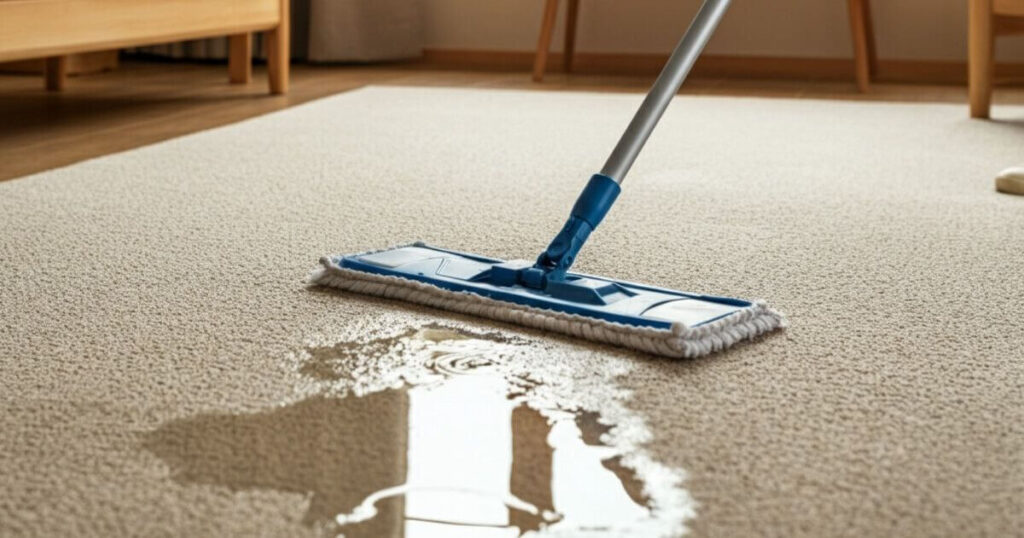
To maintain the carpet’s appearance, texture, and longevity, thoroughly drying the carpet after cleaning it is very important. Using the correct tools and following the steps outlined minimizes the chances of mold, odors, and damage to the carpet fibers.
When cleaning, whether it is a small high-traffic area or a whole-house carpet, being patient and thorough will always yield the best results. Using best practices for cleaning and drying simultaneously simplifies the work. Consider keeping fans and dehumidifiers on standby, and getting a wet vacuum if you anticipate frequent spills or during deep cleaning sessions.
For those who want to avoid the hassle, professional cleaners come equipped with commercial-grade tools that shorten drying time while consistently providing superior results.
FAQs
1. How can I dry my carpet faster after shampooing?
Speed up drying by extracting as much water as possible with a wet vac, then using multiple fans and a dehumidifier. Open windows on dry days and keep pets and kids off until fully dry.
2. Is it okay to walk on carpet before it dries completely?
No. Walking on a damp carpet can cause dirt and oils to stick, slow the drying, and even damage fibers. Wait until fully dry, typically 6–24 hours depending on the cleaning method.
3. Can I use a hairdryer to dry small wet areas?
Yes, a household hairdryer on a low heat setting can help with spot drying. Move it back and forth gently, and don’t hold it too close to avoid damage.
4. What are signs that the carpet hasn’t dried properly?
A lingering musty odor, a cool or damp feeling underfoot, or discolored spots can signal the presence of wetness beneath the surface. Use a moisture meter for confirmation.
5. How do I prevent mold after carpet cleaning?
Ensure fast, thorough drying using wet vacs, fans, and dehumidifiers. Always address pools of water promptly and inspect beneath carpets if you suspect trapped moisture; however, professional tools may be necessary for deep drying.
Ready to refresh your carpets and keep them in great shape? Check out our recommended air movers, dehumidifiers, and wet vacs on Amazon for reliable, fast results. Happy cleaning!
As an Amazon Associate, I earn from qualifying purchases.

